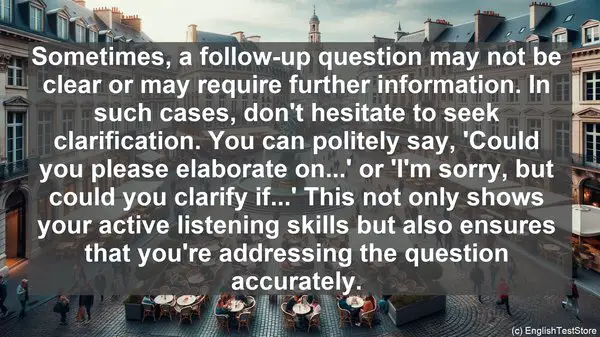Introduction: The Importance of Follow-Up Questions
In the IELTS Speaking test, it’s not just about answering the initial question. Follow-up questions play a crucial role in assessing your ability to elaborate and provide detailed responses. They test your fluency, coherence, and lexical resource. That’s why it’s essential to be well-prepared for this aspect. Today, I’ll be sharing 10 valuable techniques that will undoubtedly boost your confidence in tackling follow-up questions. Let’s dive in!
1. Paraphrasing and Expanding
Often, follow-up questions are related to the initial topic. One effective strategy is to paraphrase the question in your response, demonstrating your ability to rephrase and expand on ideas. For example, if asked about your favorite book, you can start by saying, ‘The book I’m particularly fond of…’ This not only showcases your vocabulary range but also buys you time to think and structure your answer.

2. Using Examples and Personal Experiences
To make your response more engaging and authentic, incorporate relevant examples or personal experiences. This not only adds depth to your answer but also demonstrates your ability to connect the topic to real-life situations. For instance, if asked about a memorable trip, you can share a specific incident or highlight the cultural aspects you experienced.
3. Balanced Viewpoints
In some cases, follow-up questions may require you to present both sides of an argument or express a balanced viewpoint. This showcases your ability to analyze and evaluate different perspectives. Remember to use phrases like ‘On the one hand…’ and ‘However, on the other hand…’ to structure your response and indicate a shift in opinion.
4. Linking Words and Cohesive Devices
Using appropriate linking words and cohesive devices not only enhances the flow and coherence of your response but also indicates your language proficiency. Words like ‘moreover,’ ‘in addition,’ and ‘furthermore’ can be used to add information, while ‘however,’ ‘on the contrary,’ and ‘nevertheless’ can be used to show contrast or disagreement.
5. Asking for Clarification
Sometimes, a follow-up question may not be clear or may require further information. In such cases, don’t hesitate to seek clarification. You can politely say, ‘Could you please elaborate on…’ or ‘I’m sorry, but could you clarify if…’ This not only shows your active listening skills but also ensures that you’re addressing the question accurately.
6. Using Conditionals and Hypotheticals
To demonstrate your language versatility, consider using conditionals and hypotheticals in your response. This not only showcases your knowledge of grammar but also adds depth to your answer. For example, if asked about the impact of technology, you can say, ‘If technology continues to advance at this pace, it could potentially…’ or ‘In a hypothetical scenario where technology doesn’t exist, the world would be…’
7. Providing Statistics and Data
In certain topics, incorporating relevant statistics or data can strengthen your response. This not only adds credibility but also showcases your ability to source and use information effectively. For instance, if discussing environmental issues, you can mention specific figures related to pollution levels or deforestation rates.
8. Expressing Opinions and Justifying
Follow-up questions often require you to express your opinion on a given topic. It’s crucial to not just state your viewpoint but also provide reasons or justifications. This demonstrates your ability to present a well-rounded argument. Phrases like ‘In my opinion,’ ‘I believe that,’ and ‘The reason for this is…’ can be used to express your stance.
9. Active Listening and Responding
While it’s important to deliver articulate responses, don’t overlook the significance of active listening. Pay attention to the examiner’s questions or comments and respond accordingly. This not only shows your engagement but also ensures that you’re addressing the specific query. Paraphrasing the examiner’s question in your response can also indicate active listening.
10. Summarizing and Concluding
In the IELTS Speaking test, a well-structured conclusion is as important as a strong introduction. Summarize the key points discussed and provide a concise conclusion. This not only adds a sense of closure but also showcases your ability to organize and present information effectively. Phrases like ‘To sum up’ or ‘In conclusion’ can be used to signal the end of your response.

